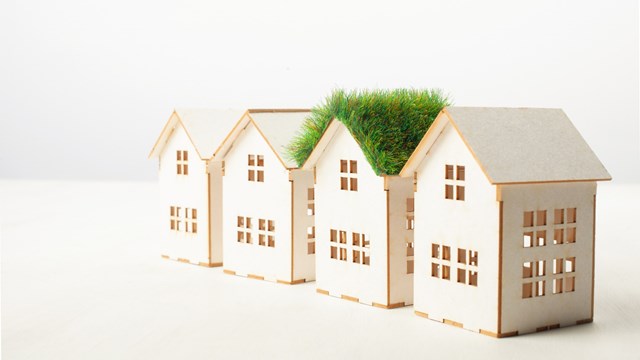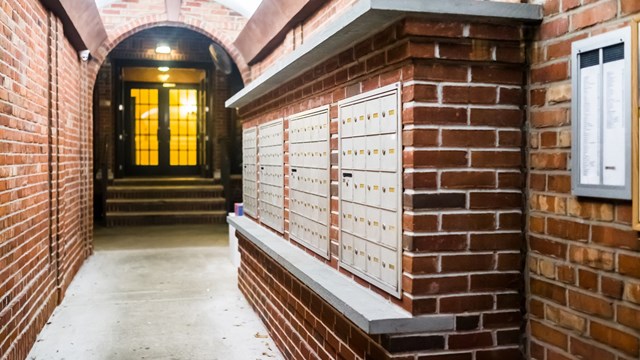
In many buildings, the roof isn't just a protective covering to fend off the elements, but also a luxurious amenity where residents enjoy patio gardens and perhaps even lounge and socialize with neighbors.
However, when celebrated architect Cesar Pelli & Associates designed The Solaire, a new 293-unit residential building in Manhattan's Battery Park City, the vision for the roof's function stretched beyond its basic purpose; the designers and developer saw green. The Solaire is North America's first "green" residential high-rise - constructed using several environmentally friendly features, including two so-called "green roofs."
A green roof is the creation of a contained live garden space on top of a human-made structure, according to the Green Roof for Healthy Cities (GRHC) in Toronto, Canada, a trade association for the green roof industry. Installing a green roof is an innovative and resourceful opportunity for buildings to reap impressive economic and environmental rewards, for both the residents of the building and the general public. Such benefits include energy conservation, improved air quality, water conservation, increase in open space and more.
Green roof plants are not planted or potted, and soil is not used because of its weight and inability to hold water. "A green roof system is an extension of the existing roof, not a bunch of potted plants," says Steven Peck, executive director of GRHC. "The system involves a special waterproof and root-repellant membrane, a drainage system, filter cloth, a lightweight growing medium, and plants."
There are two types of green roofs: intensive and extensive. Intensive green roofs - usually just called roof gardens - are accessible to residents and may include lawns, flowerbeds, shrubs and trees, and even water features like waterfalls or fountains. They are the most expensive to build and require frequent maintenance, including the inspection of the roof membrane (the most crucial element of a green roof), as well as routine inspection and upkeep of the vital drainage systems. By contrast, extensive green roofs are not accessible, require minimal maintenance, and usually include low-key vegetation like mosses, succulents, herbs and grasses.
The Solaire's design incorporates two green roofs: an intensively planted 5,000-square-foot terrace green roof on the 19th floor and a 4,800-square-foot extensive green roof on the 28th floor. The Solaire was awarded the 2004 Award of Excellence for its green roof design at a Portland, Oregon trade show in June.
"The private benefits [of having a green roof] include amenity space that residents can enjoy and perhaps even grow their own food, but a green roof also modifies the building's temperature," explains Ed Snodgrass, the president of Emory Knoll Farms Inc., based in Street, Maryland, a company that plans - and plants - green roof projects.
"Most roofing [material] is dark-colored," says Snodgrass, "so on a 90-degree day, the roof temperature can reach 170 to 200 degrees. However, since the plants cool and insulate the roof, the temperature on a green roof will just be 90 degrees - which is a 70-degree swing in surface temperature."
And therein lies the main benefit of encouraging a bunch of vegetation to take up residence on top of your building. By absorbing sunlight, shielding the roof from the elements, and acting as a natural insulator, the plants on a green roof can lead to substantial savings by reducing air conditioning costs and extending the life of the roof. Green roofs also play an increasingly important role in storm water management, absorbing much of the water that would otherwise run off in a storm, and filtering pollution from rainwater.
This horticulture technology isn't new to America, but it is not yet an integral part of residential design in the U.S., although many commercial buildings have installed green roofs, including Chicago's City Hall.
According to Leslie Hoffman, the executive director of Earth Pledge - a non-profit organization working on an initiative to green more roofs here in New York City - the key to raising awareness in the residential sector is education. "Most people don't know about green roofs," says Hoffman. "Also, getting one designed and installed takes a little bit of time, and roofing contractors seem to want to follow the same old approach about putting a garden on a roof. So we are getting up to speed."
Earth Pledge is an organization that identifies and promotes innovative techniques and technologies that restore the balance between human and natural systems. "We want to make sustainability sexy, hip and desirable," says Hoffman. "Green roofs are a significant part of our activity, and we educate thousands of architects, engineers, landscape designers, horticulturists, policymakers and scientists to get them to see the private and public benefits of a green roof. New York is currently being used as a laboratory for developing replicable solutions, but we're in a national expansion mode as we speak."
Next door to The Solaire will be a second green building - a newly constructed residential building called The Helena. The Helena will be a 600-unit residential tower with four or five green roofs. "People are starting to realize that having private green space is valuable and in certain communities there is very little green space," says Sarah Wayland-Smith, a landscape designer for Balmori Associates, the New York- and New Haven, Connecticut-based architectural firm that designed the Solaire's green roofs.
In addition, according to Earth Pledge, there will also be three new green roofs in Bushwick, Brooklyn, and Chelsea and Harlem in Manhattan. Three affordable housing organizations are completing green roof projects developed in partnership with the Viridian Project, part of Earth Pledge's Green Roofs Initiatives. The Rheingold Gardens building in Bushwick will feature a 2,400- square-foot extensive green roof atop 250 units of affordable housing. The Chelsea Residence is a 207-unit supportive housing facility that will feature two accessible intensive green roofs, totaling 5,000 square feet, and the Revella development will include the first green roof in Harlem, a 1,000-square-foot accessible roof planted with vegetables and flowers.
Green roofs not only help with storm water runoff, but are cooler and save money. A study by the Los Angeles-based Heat Island Group has found that rooftop-cooling efforts could lead to annual energy savings of $16 million. A climate model developed through the United States Department of Energy revealed that increased reflective roof surfaces and urban re-vegetation could result in temperature reductions in New York City of 3.6°F.
Some buildings may not be suitable for a green roof, including buildings with steeply- sloped building, some historic sites, or roofs with an insufficient loading capacity. "Green roofs are not for all buildings, but we don't have to cover all of the building to make a major impact on the city," said Peck.
To determine if your building is suitable for a green roof, have your managing agent arrange a consultation with a structural engineer and landscape design firm. The engineer will determine the roof's material and slope, how much exposure it gets, and whether or not it has sufficient loading capacity to accommodate the weight of planting material and vegetation. The engineer should also help determine the nature of any drainage systems, waterproofing and electrical and water supply in place.
Pricing for such a project is hard to estimate, says Charlie Miller, president of Roofscapes, Inc., a rooftop landscaping concern in Philadelphia. "Prices range due to a lot of factors, including the complexity of the roof and the design and size of the green roof." GRHC estimates that an installed extensive green roof with root repellant/waterproof membranes and irrigation may be installed for $12 to $24 per square foot.
Extensive green roofs can cost more than traditional roofs because they require more material and labor for installation. "It is an initial investment and does add maintenance cost, but if you have the time and money to invest, it will give you payback," says Snodgrass. "˜It's not an immediate payback, but it will give you a return on your investment."
"I can't see any downside to putting plants on a building," says Miller. "You're marrying plants to enhance the architecture, providing personal open green space in what would otherwise be a very sterile environment - and you're saving money on your fuel bill."






Leave a Comment